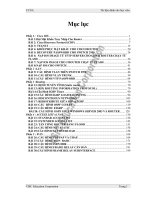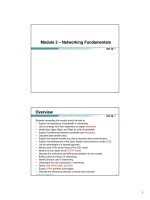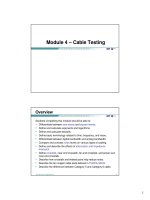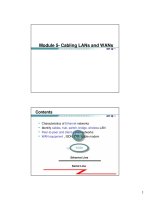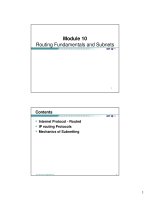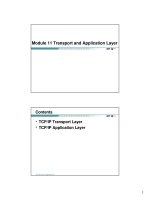Tài liệu học CCNA kỳ 4 ccna4 mod5 framerelay
Bạn đang xem bản rút gọn của tài liệu. Xem và tải ngay bản đầy đủ của tài liệu tại đây (1.44 MB, 46 trang )
1
Module 5 – Frame Relay
CCNA 4 version 3.1
Họcviệnmạng Cisco Bách Khoa - Website: www.ciscobachkhoa.com 2
Overview
• Identify the components of a Frame Relay network
• Explain the scope and purpose of Frame Relay
• Discuss the technology of Frame Relay
• Compare point-to-point and point-to-multipoint topologies
• Examine the topology of a Frame Relay network
• Configure a Frame Relay Permanent Virtual Circuit (PVC)
• Create a Frame Relay Map on a remote network
• Explain the issues of a non-broadcast multi-access
network
• Describe the need for subinterfaces and how to configure
them
• Verify and troubleshoot a Frame Relay connection
2
Họcviệnmạng Cisco Bách Khoa - Website: www.ciscobachkhoa.com 3
Introducing Frame Relay
• Frame Relay is a packet-switched, connection-oriented, WAN service.
It operates at the data link layer of the OSI reference model.
• Frame Relay uses a subset of the high-level data link control (HDLC)
protocol called Link Access Procedure for Frame Relay (LAPF).
• Frames carry data between user devices called data terminal
equipment (DTE), and the data communications equipment (DCE) at
the edge of the WAN.
– It does not define the way the data is transmitted within the service
provider’s Frame Relay cloud.
– This is ATM in many cases!
Họcviệnmạng Cisco Bách Khoa - Website: www.ciscobachkhoa.com 4
Frame Relay vs. X.25
• Frame Relay does not have the sequencing, windowing, and
retransmission mechanisms that are used by X.25.
• Without the overhead, the streamlined operation of Frame Relay
outperforms X.25.
• Typical speeds range from 56 kbps up to 2 Mbps, although higher
speeds are possible. (Up to 45 Mbps)
• The network providing the Frame Relay service can be either a carrier-
provided public network or a privately owned network.
• Because it was designed to operate on high-quality digital lines, Frame
Relay provides no error recovery mechanism.
• If there is an error in a frame it is discarded without notification.
3
Họcviệnmạng Cisco Bách Khoa - Website: www.ciscobachkhoa.com 5
Introducing Frame Relay
• A Frame Relay network may be privately owned, but it is more
commonly provided as a service by a public carrier.
• It typically consists of many geographically scattered Frame Relay
switches interconnected by trunk lines.
• Frame Relay is often used to interconnect LANs. When this is the
case, a router on each LAN will be the DTE.
• A serial connection, such as a T1/E1 leased line, will connect the
router to a Frame Relay switch of the carrier at the nearest point-of-
presence for the carrier. (access circuit)
Access circuits
Họcviệnmạng Cisco Bách Khoa - Website: www.ciscobachkhoa.com 6
DTE – Data Terminal Equipment
• DTEs generally are considered to be terminating equipment for a
specific network and typically are located on the premises of the
customer.
• The customer may also own this equipment.
• Examples of DTE devices are routers and Frame Relay Access
Devices (FRADs).
• A FRAD is a specialized device designed to provide a connection
between a LAN and a Frame Relay WAN.
4
Họcviệnmạng Cisco Bách Khoa - Website: www.ciscobachkhoa.com 7
DCE – Data Communications Equipment
• DCEs are carrier-owned internetworking devices.
• The purpose of DCE equipment is to provide clocking and switching
services in a network.
• In most cases, these are packet switches, which are the devices that
actually transmit data through the WAN.
• The connection between the customer and the service provider is
known as the User-to-Network Interface (UNI).
• The Network-to-Network Interface (NNI) is used to describe how
Frame Relay networks from different providers connect to each other.
UNI NNI
Họcviệnmạng Cisco Bách Khoa - Website: www.ciscobachkhoa.com 8
Frame Relay terminology
• The connection through the Frame Relay network between two DTEs is
called a virtual circuit (VC).
• Switched Virtual Circuits (SVCs) are Virtual circuits may be established
dynamically by sending signaling messages to the network.
• However, SVCs are not very common.
• Permanent Virtual Circuits (PVCs) are more common.
• PVC are VCs that have been preconfigured by the carrier are used.
• The switching information for a VC is stored in the memory of the switch.
An SVC between the same two
DTEs may change.
A PVC between the same two
DTEs will always be the same.
Path may change. Always same Path.
5
Họcviệnmạng Cisco Bách Khoa - Website: www.ciscobachkhoa.com 9
Access Circuits and Cost Savings
• The FRAD or router connected to the Frame Relay network may have
multiple virtual circuits connecting it to various end points.
• This makes it a very cost-effective replacement for a full mesh of
access lines.
• Each end point needs only a single access line and interface.
• More savings arise as the capacity of the access line is based on the
average bandwidth requirement of the virtual circuits, rather than on
the maximum bandwidth requirement.
• Note: Also do not have to pay for leased line between two sites even
when no traffic is being sent.
Họcviệnmạng Cisco Bách Khoa - Website: www.ciscobachkhoa.com 10
IETF Frame Relay Frame
• Cisco routers support two types of Frame Relay headers.
– Cisco, which is a 4-byte header.
– IETF, which is a 2-byte header that conforms to the IETF
standards.
• The Cisco proprietary 4-byte header is the default and cannot be used
if the router is connected to another vendor's equipment across a
Frame Relay network.
6
Họcviệnmạng Cisco Bách Khoa - Website: www.ciscobachkhoa.com 11
IETF Frame
Relay Frame
Họcviệnmạng Cisco Bách Khoa - Website: www.ciscobachkhoa.com 12
IETF Frame Relay Frame
7
Họcviệnmạng Cisco Bách Khoa - Website: www.ciscobachkhoa.com 13
DLCI
• A data-link connection identifier (DLCI) identifies the logical VC
between the CPE and the Frame Relay switch.
• The Frame Relay switch maps the DLCIs between each pair of routers
to create a PVC.
• DLCIs have local significance, although there some implementations
that use global DLCIs.
• DLCIs 0 to 15 and 1008 to 1023 are reserved for special purposes.
• Service providers assign DLCIs in the range of 16 to 1007.
– DLCI 1019, 1020: Multicasts
– DLCI 1023: Cisco LMI
– DLCI 0: ANSI LMI
Họcviệnmạng Cisco Bách Khoa - Website: www.ciscobachkhoa.com 14
DLCI
• Your Frame Relay provider sets up the DLCI numbers to be used by
the routers for establishing PVCs.
8
Họcviệnmạng Cisco Bách Khoa - Website: www.ciscobachkhoa.com 15
Frame Relay bandwidth and flow control
Note:
• I am going to use information from CCNA version 2.0 and CCNP 2
version 3.0 to explain this topic.
• I do not like how this section (5.1.4) was written as I do not think it
explains the topic very well at all.
Họcviệnmạng Cisco Bách Khoa - Website: www.ciscobachkhoa.com 16
Frame Relay bandwidth
and flow control
• Local access rate – This is the clock speed or port speed of the
connection or local loop to the Frame Relay cloud.
– It is the rate at which data travels into or out of the network,
regardless of other settings.
• Committed Information Rate (CIR) – This is the rate, in bits per
second, at which the Frame Relay switch agrees to transfer data.
– The rate is usually averaged over a period of time, referred to as
the committed rate measurement interval (Tc).
– In general, the duration of Tc is proportional to the "burstiness" of
the traffic.
The first thing we need to do is
become familiar with some of
the terminology.
9
Họcviệnmạng Cisco Bách Khoa - Website: www.ciscobachkhoa.com 17
Frame Relay bandwidth and flow control
• Oversubscription – Oversubscription is when the sum of the CIRs on
all the VCs exceeds the access line speed.
– Oversubscription can also occur when the access line can support
the sum of CIRs purchased, but not of the CIRs plus the bursting
capacities of the VCs.
– Oversubscription increases the likelihood that packets will be
dropped.
per VC
Họcviệnmạng Cisco Bách Khoa - Website: www.ciscobachkhoa.com 18
Frame Relay bandwidth and flow control
• Committed burst (Bc) – The maximum number of bits that the switch
agrees to transfer during any Tc.
– The higher the Bc-to-CIR ratio, the longer the switch can handle a
sustained burst.
– For example, if the Tc is 2 seconds and the CIR is 32 kbps, the Bc
is 64 kbps.
– The Tc calculation is Tc = Bc/CIR.
• Committed Time Interval (Tc) – Tc is not a recurrent time interval. It is
used strictly to measure inbound data, during which time it acts like a
sliding window. Inbound data triggers the Tc interval.
Tc = 2 seconds
Bc = 64 kb
CIR = 32 kbps
10
Họcviệnmạng Cisco Bách Khoa - Website: www.ciscobachkhoa.com 19
Frame Relay bandwidth
and flow control
• Excess burst (Be) – This is the maximum number of uncommitted bits
that the Frame Relay switch attempts to transfer beyond the CIR.
– Excessive Burst (Be) is dependent on the service offerings
available from your vendor, but it is typically limited to the port
speed of the local access loop.
• Excess Information Rate (EIR) – This defines the maximum
bandwidth available to the customer, which is the CIR plus the Be.
– Typically, the EIR is set to the local access rate.
– In the event the provider sets the EIR to be lower than the local
access rate, all frames beyond that maximum can be discarded
automatically, even if there is no congestion.
Họcviệnmạng Cisco Bách Khoa - Website: www.ciscobachkhoa.com 20
Frame Relay bandwidth
and flow control
• Forward Explicit Congestion Notification (FECN) – When a Frame
Relay switch recognizes congestion in the network, it sends an FECN
packet to the destination device
.
– This indicates that congestion has occurred.
• Backward Explicit Congestion Notification (BECN) – When a
Frame Relay switch recognizes congestion in the network, it sends a
BECN packet to the source router
.
– This instructs the router to reduce the rate at which it is sending
packets.
– With Cisco IOS Release 11.2 or later, Cisco routers can respond to
BECN notifications.
– This topic is discussed later in this module.
11
Họcviệnmạng Cisco Bách Khoa - Website: www.ciscobachkhoa.com 21
Frame Relay bandwidth
and flow control
• Discard eligibility (DE) bit – When the router or switch detects
network congestion, it can mark the packet "Discard Eligible".
– The DE bit is set on the traffic that was received after the CIR was
met.
– These packets are normally delivered. However, in periods of
congestion, the Frame Relay switch will drop packets with the DE
bit set first.
Họcviệnmạng Cisco Bách Khoa - Website: www.ciscobachkhoa.com 22
• Several factors determine the rate at which a customer can send data
on a Frame Relay network.
• Foremost in limiting the maximum transmission rate is the capacity of
the local loop to the provider.
• If the local loop is a T1, no more than 1.544 Mbps can be sent.
• In Frame Relay terminology, the speed of the local loop is called the
local access rate.
• Providers use the CIR parameter to provision network resources and
regulate usage.
• For example, a company with a T1 connection to the packet-switched
network (PSN) may agree to a CIR of 768 Kbps.
• This means that the provider guarantees 768 Kbps of bandwidth to the
customer’s link at all times.
Frame Relay bandwidth
12
Họcviệnmạng Cisco Bách Khoa - Website: www.ciscobachkhoa.com 23
Frame Relay bandwidth
• Typically, the higher the CIR, the higher the cost of service.
• Customers can choose the CIR that is most appropriate to their
bandwidth needs, as long as the CIR is less than or equal to the local
access rate.
• If the CIR of the customer is less than the local access rate, the
customer and provider agree on whether bursting above the CIR is
allowed.
• If the local access rate is T1 or 1.544 Mbps, and the CIR is 768 Kbps,
half of the potential bandwidth (as determined by the local access rate)
remains available.
Họcviệnmạng Cisco Bách Khoa - Website: www.ciscobachkhoa.com 24
Frame Relay bandwidth
• Many providers allow their customers to purchase a CIR of 0 (zero).
• This means that the provider does not guarantee any throughput.
• In practice, customers usually find that their provider allows them to
burst over the 0 (zero) CIR virtually all of the time.
• If a CIR of 0 (zero) is purchased, carefully monitor performance in
order to determine whether or not it is acceptable.
• Frame Relay allows a customer and provider to agree that under
certain circumstances, the customer can “burst” over the CIR.
• Since burst traffic is in excess of the CIR, the provider does not
guarantee that it will deliver the frames.
13
Họcviệnmạng Cisco Bách Khoa - Website: www.ciscobachkhoa.com 25
Frame Relay bandwidth
• Either a router or a Frame Relay switch tags each frame that is
transmitted beyond the CIR as eligible to be discarded.
• When a frame is tagged DE, a single bit in the Frame Relay frame is
set to 1.
• This bit is known as the discard eligible (DE) bit.
• The Frame Relay specification also includes a protocol for congestion
notification.
• This mechanism relies on the FECN/ BECN bits in the Q.922 header of
the frame.
• The provider’s switches or the customer’s routers can selectively set
the DE bit in frames.
• These frames will be the first to be dropped when congestion occurs.
Họcviệnmạng Cisco Bách Khoa - Website: www.ciscobachkhoa.com 26
LMI – Local Management Interface
• LMI is a signaling standard between
the DTE and the Frame Relay switch.
• LMI is responsible for managing the connection and maintaining
the status between devices.
• LMI includes:
– A keepalive mechanism, which verifies that data is flowing
– A multicast mechanism, which provides the network server
(router) with its local DLCI.
– The multicast addressing, which can give DLCIs global rather
than local significance in Frame Relay networks (not common).
– A status mechanism, which provides an ongoing status on the
DLCIs known to the switch
14
Họcviệnmạng Cisco Bách Khoa - Website: www.ciscobachkhoa.com 27
LMI
• In order to deliver the first LMI services to customers as soon as
possible, vendors and standards committees worked separately to
develop and deploy LMI in early Frame Relay implementations.
• The result is that there are three types of LMI, none of which is
compatible with the others.
• Cisco, StrataCom, Northern Telecom, and Digital Equipment
Corporation (Gang of Four) released one type of LMI, while the ANSI
and the ITU-T each released their own versions.
• The LMI type must match between the provider Frame Relay switch
and the customer DTE device.
LMI
Họcviệnmạng Cisco Bách Khoa - Website: www.ciscobachkhoa.com 28
LMI
• In Cisco IOS releases prior to 11.2, the Frame Relay interface must be
manually configured to use the correct LMI type, which is furnished by
the service provider.
• If using Cisco IOS Release 11.2 or later, the router attempts to
automatically detect the type of LMI used by the provider switch.
• This automatic detection process is called LMI autosensing.
• No matter which LMI type is used, when LMI autosense is active, it
sends out a full status request to the provider switch.
LMI
15
Họcviệnmạng Cisco Bách Khoa - Website: www.ciscobachkhoa.com 29
LMI
• Frame Relay devices can now listen in on both DLCI 1023 or Cisco
LMI and DLCI 0 or ANSI and ITU-T simultaneously.
• The order is ansi, q933a, cisco and is done in rapid succession to
accommodate intelligent switches that can handle multiple formats
simultaneously.
• The Frame Relay switch uses LMI to report the status of configured
PVCs.
• The three possible PVC states are as follows:
– Active state – Indicates that the connection is active and that
routers can exchange data.
– Inactive state – Indicates that the local connection to the Frame
Relay switch is working, but the remote router connection to the
Frame Relay switch is not working.
– Deleted state – Indicates that no LMI is being received from the
Frame Relay switch, or that there is no service between the CPE
router and Frame Relay switch.
Họcviệnmạng Cisco Bách Khoa - Website: www.ciscobachkhoa.com 30
DLCI Mapping to Network Address
• Manual
– Manual: Administrators use a frame relay map statement.
• Dynamic
– Inverse Address Resolution Protocol (I-ARP) provides a given
DLCI and requests next-hop protocol addresses for a specific
connection.
– The router then updates its mapping table and uses the information
in the table to forward packets on the correct route.
16
Họcviệnmạng Cisco Bách Khoa - Website: www.ciscobachkhoa.com 31
Inverse ARP
• Once the router learns from the switch about available PVCs and their
corresponding DLCIs, the router can send an Inverse ARP request to
the other end of the PVC. (unless statically mapped – later)
• For each supported and configured protocol on the interface, the router
sends an Inverse ARP request for each DLCI. (unless statically
mapped)
• In effect, the Inverse ARP request asks the remote station for its Layer
3 address.
• At the same time, it provides the remote system with the Layer 3
address of the local system.
• The return information from the Inverse ARP is then used to build the
Frame Relay map.
12
Họcviệnmạng Cisco Bách Khoa - Website: www.ciscobachkhoa.com 32
Inverse ARP
• Inverse Address Resolution Protocol (Inverse ARP) was developed to
provide a mechanism for dynamic DLCI to Layer 3 address maps.
• Inverse ARP works much the same way Address Resolution Protocol
(ARP) works on a LAN.
• However, with ARP, the device knows the Layer 3 IP address and
needs to know the remote data link MAC address.
• With Inverse ARP, the router knows the Layer 2 address which is the
DLCI, but needs to know the remote Layer 3 IP address.
17
Họcviệnmạng Cisco Bách Khoa - Website: www.ciscobachkhoa.com 33
• cisco - Default.
– Use this if connecting to another Cisco router.
• Ietf - Select this if connecting to a non-Cisco router.
– RFC 1490
Router(config-if)#encapsulation frame-relay {cisco | ietf}
Frame Relay Encapsulation
Họcviệnmạng Cisco Bách Khoa - Website: www.ciscobachkhoa.com 34
Frame Relay LMI
• It is important to remember that the Frame Relay service provider
maps the virtual circuit within the Frame Relay network connecting the
two remote customer premises equipment (CPE) devices that are
typically routers.
• Once the CPE device, or router, and the Frame Relay switch are
exchanging LMI information, the Frame Relay network has everything
it needs to create the virtual circuit with the other remote router.
• The Frame Relay network is not like the Internet where any two
devices connected to the Internet can communicate.
• In a Frame Relay network, before two routers can exchange
information, a virtual circuit between them must be set up ahead of
time by the Frame Relay service provider.
Router(config-if)#frame-relay lmi-type {ansi | cisco | q933a}
18
Họcviệnmạng Cisco Bách Khoa - Website: www.ciscobachkhoa.com 35
HubCity(config)# interface serial 0
HubCity(config-if)# ip address 172.16.1.2 255.255.255.0
HubCity(config-if)# encapsulation frame-relay
Spokane(config)# interface serial 0
Spokane(config-if)# ip address 172.16.1.1 255.255.255.0
Spokane(config-if)# encapsulation frame-relay
Frame Relay
Network
Headquarters
Hub City
Satellite Office 1
Spokane
172.16.1.1172.16.1.2
DLCI 101 DLCI 102
Minimum Frame Relay Configuration
Họcviệnmạng Cisco Bách Khoa - Website: www.ciscobachkhoa.com 36
• Cisco Router is now ready to act as a Frame-Relay DTE device.
The following process occurs:
1. The interface is enabled.
2. The Frame-Relay switch announces the configured DLCI(s) to the
router.
3. Inverse ARP is performed to map remote network layer addresses to
the local DLCI(s).
The routers can now ping each other!
Minimum Frame Relay Configuration
Frame Relay
Network
Headquarters
Hub City
Satellite Office 1
Spokane
172.16.1.1172.16.1.2
DLCI 101 DLCI 102
19
Họcviệnmạng Cisco Bách Khoa - Website: www.ciscobachkhoa.com 37
HubCity# show frame-relay map
Serial0 (up): ip 172.16.1.1 dlci 101, dynamic, broadcast,
status defined, active
Frame Relay
Network
Headquarters
Hub City
Satellite Office 1
Spokane
172.16.1.1172.16.1.2
DLCI 101 DLCI 102
Inverse ARP
• dynamic refers to the router learning the IP address via Inverse ARP
• The DLCI 101 is configured on the Frame Relay Switch by the
provider.
• We will see this in a moment.
Họcviệnmạng Cisco Bách Khoa - Website: www.ciscobachkhoa.com 38
Inverse ARP Limitations
• Inverse ARP only resolves network addresses of remote Frame-Relay
connections that are directly connected.
• Inverse ARP does not work with Hub-and-Spoke connections. (We will
see this in a moment.)
• When using dynamic address mapping, Inverse ARP requests a next-
hop protocol address for each active PVC.
• Once the requesting router receives an Inverse ARP response, it
updates its DLCI-to-Layer 3 address mapping table.
• Dynamic address mapping is enabled by default for all protocols
enabled on a physical interface.
• If the Frame Relay environment supports LMI autosensing and Inverse
ARP, dynamic address mapping takes place automatically.
• Therefore, no static address mapping is required.
Frame Relay
Network
Headquarters
Hub City
Satellite Office 1
Spokane
172.16.1.1172.16.1.2
DLCI 101 DLCI 102
20
Họcviệnmạng Cisco Bách Khoa - Website: www.ciscobachkhoa.com 39
Configuring Frame Relay maps
• If the environment does not support LMI autosensing and Inverse ARP,
a Frame Relay map must be manually configured.
• Use the frame-relay map command to configure static address
mapping.
• Once a static map for a given DLCI is configured, Inverse ARP is
disabled on that DLCI.
• The broadcast keyword is commonly used with the frame-relay
map command.
• The broadcast keyword provides two functions.
– Forwards broadcasts when multicasting is not enabled.
– Simplifies the configuration of OSPF for nonbroadcast networks
that use Frame Relay.
Router(config-if)#frame-relay map protocol protocol-address
dlci [broadcast] [ietf | cisco]
Họcviệnmạng Cisco Bách Khoa - Website: www.ciscobachkhoa.com 40
Frame
Relay Maps
Remote IP
Address
Local DLCI
Uses cisco
encapsulation for
this DLCI (not
needed, default)
By default,
cisco is the
default
encapsulation
21
Họcviệnmạng Cisco Bách Khoa - Website: www.ciscobachkhoa.com 41
More on Frame Relay Encapsulation
• If the Cisco encapsulation is configured on a serial interface, then by
default, that encapsulation applies to all VCs on that serial interface.
• If the equipment at the destination is Cisco and non-Cisco, configure
the Cisco encapsulation on the interface and selectively configure IETF
encapsulation per DLCI, or vice versa.
• These commands configure the Cisco Frame Relay encapsulation for
all PVCs on the serial interface.
• Except for the PVC corresponding to DLCI 49, which is explicitly
configured to use the IETF encapsulation.
Applies to all DLCIs unless
configured otherwise
Họcviệnmạng Cisco Bách Khoa - Website: www.ciscobachkhoa.com 42
V
erifying Frame Relay interface
configuration
• The show interfaces serial command displays
information regarding the encapsulation and the status of
Layer 1 and Layer 2.
• It also displays information about the multicast DLCI, the
DLCIs used on the Frame Relay-configured serial
interface, and the DLCI used for the LMI signaling.
22
Họcviệnmạng Cisco Bách Khoa - Website: www.ciscobachkhoa.com 43
show interfaces serial
• To simplify the WAN management, use the description command
at the interface level to record the circuit number.
Atlanta(config)#interface serial 0/0
Atlanta(config-if)#description Circuit-05QHDQ101545-080TCOM-002
Atlanta(config-if)#^z
Atlanta#show interfaces serial 0/0
Serial 0/0 is up, line protocol is up Hardware is MCI Serial
Description Circuit-05QHDQ101545-080TCOM-002
Internet address is 150.136.190.203, subnet mask 255.255.255.0
MTU 1500 bytes, BW 1544 Kbit, DLY 20000 uses, rely 255/255, load 1/255
Họcviệnmạng Cisco Bách Khoa - Website: www.ciscobachkhoa.com 44
show frame-relay pvc
• The show frame-relay pvc command displays the status of each
configured connection, as well as traffic statistics.
• This command is also useful for viewing the number of Backward
Explicit Congestion Notification (BECN) and Forward Explicit
Congestion Notification (FECN) packets received by the router.
• The command show frame-relay pvc shows the status of all
PVCs configured on the router.
• If a single PVC is specified, only the status of that PVC is shown.
23
Họcviệnmạng Cisco Bách Khoa - Website: www.ciscobachkhoa.com 45
show frame-relay map
• The show frame-relay map command displays the current map
entries and information about the connections.
Họcviệnmạng Cisco Bách Khoa - Website: www.ciscobachkhoa.com 46
show frame-relay lmi
• The show frame-relay lmi command displays LMI traffic statistics
showing the number of status messages exchanged between the local
router and the Frame Relay switch.
24
Họcviệnmạng Cisco Bách Khoa - Website: www.ciscobachkhoa.com 47
clear frame-relay-inarp
• To clear dynamically created Frame Relay maps, which are created
using Inverse ARP, use the clear frame-relay-inarp command.
Họcviệnmạng Cisco Bách Khoa - Website: www.ciscobachkhoa.com 48
Troubleshooting the Frame Relay
configuration
• Use the debug frame-relay lmi command to
determine whether the router and the Frame Relay switch
are sending and receiving LMI packets properly.
25
Họcviệnmạng Cisco Bách Khoa - Website: www.ciscobachkhoa.com 49
debug frame-relay lmi (continued)
• The possible values of the status field are as follows:
• 0x0 – Added/inactive means that the switch has this DLCI programmed but for
some reason it is not usable. The reason could possibly be the other end of the
PVC is down.
• 0x2 – Added/active means the Frame Relay switch has the DLCI and
everything is operational.
• 0x4 – Deleted means that the Frame Relay switch does not have this DLCI
programmed for the router, but that it was programmed at some point in the
past. This could also be caused by the DLCIs being reversed on the router, or
by the PVC being deleted by the service provider in the Frame Relay cloud.
Họcviệnmạng Cisco Bách Khoa - Website: www.ciscobachkhoa.com 50
Frame Relay Topologies


